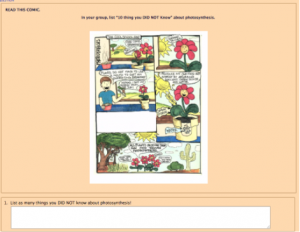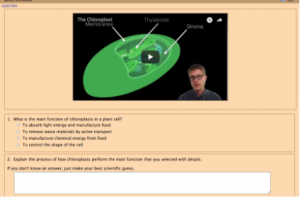I customized the Photosynthesis: Initial Ideas activity on the WISE platform. Personally, I have not taught science above grade 6. Therefore this was a topic I could relate to you. From the outset, I found the original inquiry project to be very text heavy with no visuals, audios or videos. I believe the creator of this project did not take into account the constructivist approach, where learning is active social and situated to alter and empower the learner and in this case through the use of technology.
The original Photosynthesis: Initial Ideas activity did not design and develop their project around the four key components for knowledge integration (Slotta, J. D., & Linn, M. C. 2009). First, making learning accessible is designed to guide students to hypothesize, investigate and make possible predictions. Moreover, asking them to interpret the results of activity based on their predictions. Second, the many multiple choice questions did not allow for making thinking visible. There were a few open-ended questions that did provide some opportunities for the learner to gain insight into their own learning. Third, this article noted the importance of the Learner from others. This project could have included peer review activities where students are guided to critique others thoughts and opinions. Especially, since this more of background knowledge project, it would be vitally important to conduct these types of discussion to alleviate any misconceptions about photosynthesis. Lastly, the authors illustrated that “WISE has many different tools and activities to promote autonomous learning, such as graphing, drawing, data collection, online discussion, note-taking concept-mapping, peer-exchange and reflection” (p. 70), none of the features were used in this project to enhance the learning for the student.
I altered the first three activities in this project to guide students in a more autonomous form of learning that reflects that nature of scientific investigation.
#1 I introduced the concept of photosynthesis by incorporating a comic strip. Constructivist educators believe that prior knowledge impacts the learning process (Vygotsky, Lev S. 1987). In trying to solve scientific problems students have the opportunity to construct new information into their existing understanding of photosynthesis actively.

#2 As reiterated in the Jasper project, video can be as good an instructional tool to give real-world facts or demonstrate procedural requirements that assist with solidifying the information into long-term memory. For this page, I video gives visual cues of the importance of food has for all living things.

#3 chloroplasts can be a complex concept for students to understand. The luxury of the video, is that students can rewatch and understanding those misconceptions. By scaffolding the knowledge (SKI) through the WISE activities students are guided through the process of scientific investigation Furtak, E. M. (2006).

In closing, I did ask a colleague, with significant science and teaching experience, to navigate through the WISE platform. Interestingly, he came back saying it would not be an instructional tool he would use because the setup and limitation to customize the overall project would deter him from using in the future. I would like to further explore if there other options for providing effective science materials online.
Furtak, E. M. (2006). The problem with answers: An exploration of guided scientific inquiry teaching. Science Education, 90(3), 453-467.
Slotta, J. D., & Linn, M. C. (2009). WISE science: Web-based inquiry in the classroom. Teachers College Press.
Vygotsky, Lev S. 1987.. Collected Works of L. S. Vygotsky, Vol. 1: Problems of General Psychology, trans. Norris Minick. New York: Plenum.
